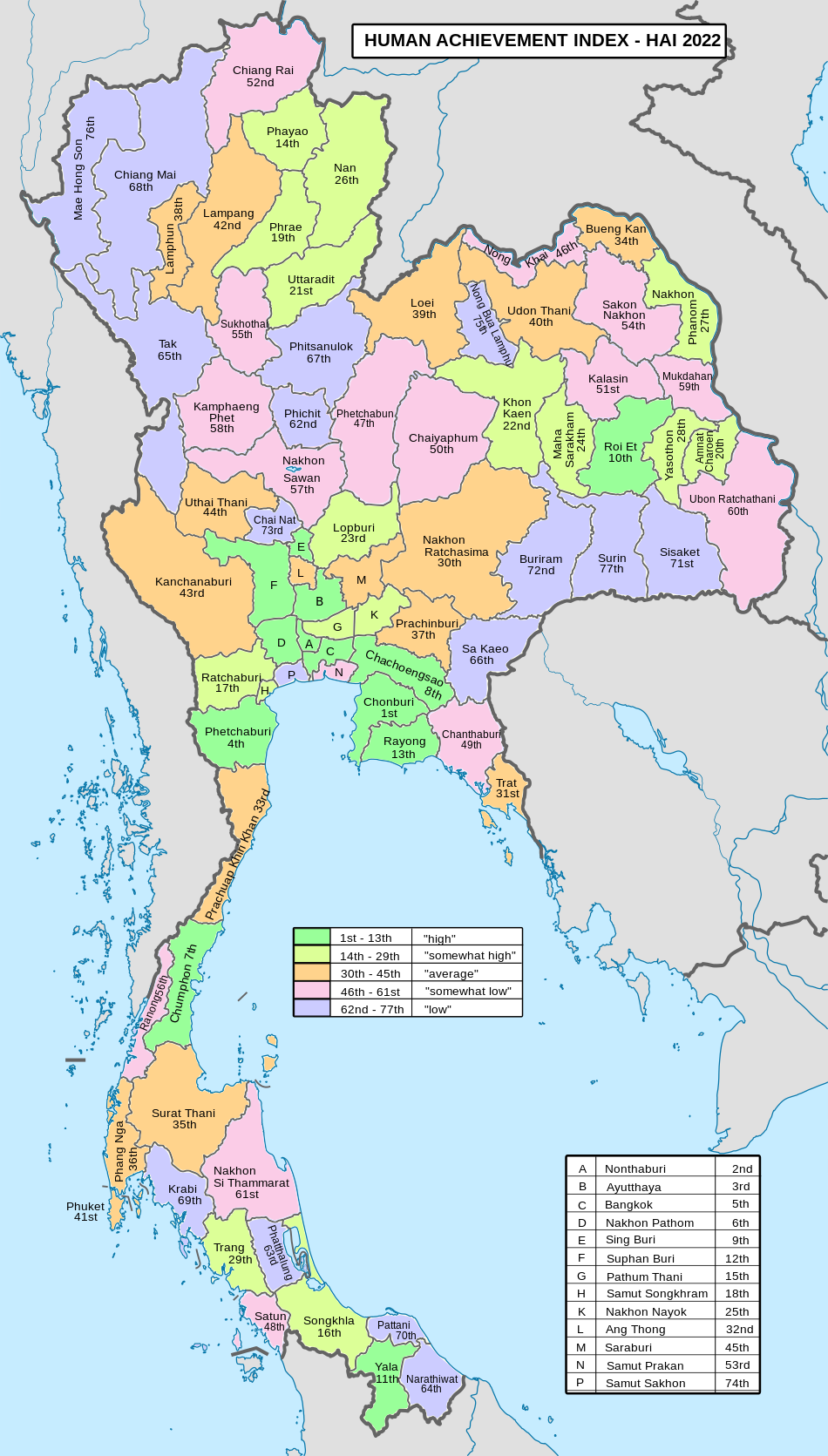Chiang Rai province
Chiang Rai
เชียงราย ᨩ᩠ᨿᨦᩁᩣ᩠ᨿ | |
|---|---|
Doi Tung Royal Villa, Phu Chi Fa | |
|
เชียงราย | |
| Accession into Kingdom of Siam | 1910 |
| Accession into Kingdom of Thailand | 1932 |
| Website | www |
Chiang Rai (Thai: เชียงราย, pronounced [t͡ɕʰīa̯ŋ.rāːj]; Northern Thai: ᨩ᩠ᨿᨦᩁᩣ᩠ᨿ, pronounced [t͡ɕīa̯ŋ.hāːj]) is one of Thailand's seventy-six provinces, which lies in upper northern Thailand and is Thailand's northernmost province. It is bordered by the Shan State of Myanmar to the north, Bokeo province of Laos to the east, Phayao to the south, Lampang to the southwest, and Chiang Mai to the west. The provinces is linked to Houayxay Laos by the Fourth Thai–Lao Friendship Bridge that spans the Mekong.
| Chiang Rai province | |
|---|---|
 | |
| Thai name | |
| Thai | เชียงราย |
| RTGS | Chiang Rai |
| Northern Thai name | |
| Northern Thai | ᨩ᩠ᨿᨦᩁᩣ᩠ᨿ [tɕiaŋ.haːj] |
Geography
The average elevation of the province is 580 metres (1,903 ft). The north of the province is part of the so-called
While the eastern part of the province is characterized by relatively flat river plains, the northern and western part consists of the hilly terrain of the
National parks
There are seven national parks, along with one other national park, make up
- Doi Luang National Park, 1,169 km2 (451 sq mi)[6]: 61
- Lam Nam Kok National Park, 587 km2 (227 sq mi)[7]: 18
- Mae Puem National Park, 351 km2 (136 sq mi)[6]: 120
- Phu Sang National Park, 285 km2 (110 sq mi)[6]: 98
- Khun Chae National Park, 270 km2 (100 sq mi)[6]: 80
- Phu Chi Fa National Park, 93 km2 (36 sq mi)[7]: 21
- Tham Luang–Khun Nam Nang Non National Park, 19 km2 (7.3 sq mi)[7]: 7
History
Chiang Rai was founded in 1262. Populations have dwelled in Chiang Rai since the 7th century and it became the center of the
Chiang Rai province's golden triangle bordering Laos and Burma was once the hub of opium production.
Chiang Rai became a province in 1910, after being part of the
Chiang Rai province is a transit point for Rohingya refugees from Myanmar (Burma) who are transported there from Sangkhlaburi district in Kanchanaburi province.[8]
Demographics
The majority of the population are ethnic
Ethnic groups

Khon Muang are the city folk who originally came from Chiang Mai, Lamphun, Lampang, and Phrae. Culturally, they design their houses having only one floor with wooden gable decorations called "ka-lae". They are known for their craftsmanship in wood carving, weaving, lacquer ware, and musical instruments.
Tai Yai (ไทใหญ่) (Shan) are a Tai ethnic group who primarily live in what is now Shan State in Burma, and also in Mae Hong Son province in Thailand. They grow rice, farm, raise cattle, and trade. Their craftsmanship lies in weaving, pottery, wood carving, and bronze ware.
Akha have the largest population of any hill tribe in the region. Originating from Tibet and southern China, they dwell on high ground around 1,200 meters above sea level. Within their villages they build spirit gateways to protect them from evil spirits.
Lahu (Musor) are also from the Yunnanese area and live in high areas. They are known as hunters and planters. Karen live in various areas of the region which have valleys and riverbanks.
Hmong from southern China, inhabit high ground. They raise livestock and grow rice, corn, tobacco, and cabbage. They are also known for their embroidery and silver.
Tai Lue (Dai) live in dwellings of usually only a single room wooden house built on high poles. They are skilled in weaving.
Lisu from southern China and Tibet are renowned for their colorful dress and also build their dwellings on high stilts. They harvest rice and corn and their men are skilled in hunting.
Yao (Mien) reside along mountain sides and grow corn and other crops. They are skilled blacksmiths, silversmiths, and embroiders.

Symbols
The seal of the province shows a white elephant, the royal symbol, recalling that Chiang Rai was founded by King Mengrai, according to legend because his elephant liked the place.
The
The former provincial slogan was "เหนือสุดในสยาม อร่ามดอยตุง ผดุงวัฒนธรรม รสล้ำข้าวสาร หอมหวานลิ้นจี่ สตรีโสภา ชาเลิศรส สัปปะรดนางแล", 'Northernmost of Siam, beautiful
The current slogan is "เหนือสุดในสยาม ชายแดนสามแผ่นดิน ถิ่นวัฒนธรรมล้านนา ล้ำค่าพระธาตุดอยตุง", 'Northernmost of Siam, frontier of three lands, the home of Lan Na culture and Doi Tung Temple'.
Hospitals
- Kasemrad Sriburin General Hospital, Private hospital.
- Chiangrai Prachanukroh Hospital, Public hospital.
Tourism
Chiang Rai is known for its beautiful landscapes, cultural heritage, and unique attractions. The city attracts a large number of tourists every year who come to explore its temples, markets, museums, and its natural beauty.[9]
One of the most popular attractions is the Wat Rong Khun,[10] Another attraction is the Golden Triangle, which is the meeting point of Thailand, Laos, and Myanmar and offers views of the Mekong River and the surrounding mountains. Other popular attractions in Chiang Rai include the Doi Tung Royal Villa, Baan Dam Museum, the Hill Tribe Museum and Education Center, and the Khun Korn Waterfall.[11]
Chiang Rai is also a popular base for exploring the surrounding areas, including the Mae Sai border town, the Chiang Saen historical city, and the Doi Mae Salong tea plantations.
Transport

Air
Chiang Rai International Airport has domestic flights to both Bangkok airports, which connect to regional and international flights.
Boat
There is daily boat service between Chiang Rai and Tha Ton.
Rail
There is no railway system in Chiang Rai. The nearest station is
Road
Chiang Rai province is intersected by
Decent bus services are available in the province. In more remote areas, songthaews are the norm.
Administrative divisions

Provincial government
Chiang Rai is divided into 18 districts ().
|
|
|
Local government
As of 26 November 2019 there are:
Human achievement index 2022
Since 2003, United Nations Development Programme (UNDP) in Thailand has tracked progress on human development at sub-national level using the Human achievement index (HAI), a composite index covering all the eight key areas of human development. National Economic and Social Development Board (NESDB) has taken over this task since 2017.[3]
| Rank | Classification |
| 1–13 | "High" |
| 14–29 | "Somewhat high" |
| 30–45 | "Average" |
| 46–61 | "Somewhat low" |
| 62–77 | "Low" |
| Map with provinces and HAI 2022 rankings |

|
Gallery
-
Pu Kaeng Waterfall, Doi Luang National Park
-
Huai Mak Liam Hot Spring, Lam Nam Kok National Park
-
A road tunnel decorated with Thai style art
-
Elephants, Kok River
-
Kok River
-
Chiang Saen, Mekong River
-
Chiang Saen
References
- ^ a b "ตารางที่ 2 พี้นที่ป่าไม้ แยกรายจังหวัด พ.ศ.2562" [Table 2 Forest area Separate province year 2019]. Royal Forest Department (in Thai). 2019. Retrieved 6 April 2021, information, Forest statistics Year 2019, Thailand boundary from Department of Provincial Administration in 2013
{{cite web}}: CS1 maint: postscript (link) - ^ a b รายงานสถิติจำนวนประชากรและบ้านประจำปี พ.ส.2562 [Statistics, population and house statistics for the year 2019]. Registration Office Department of the Interior, Ministry of the Interior. stat.bora.dopa.go.th (in Thai). 31 December 2019. Archived from the original on 14 June 2019. Retrieved 26 February 2020.
- ^ a b "ข้อมูลสถิติดัชนีความก้าวหน้าของคน ปี 2565 (PDF)" [Human Achievement Index Databook year 2022 (PDF)]. Office of the National Economic and Social Development Council (NESDC) (in Thai). Retrieved 12 March 2024, page 26
{{cite web}}: CS1 maint: postscript (link) - ISSN 1686-0799. Retrieved 22 January 2020.
- ^ "Thailand - Mountains beginning with Doi Tung - Doi Tung to Doi Wiang Pha". www.indexmundi.com.
- ^ a b c d "ข้อมูลพื้นที่อุทยานแห่งชาติ ที่ประกาศในราชกิจจานุบกษา 133 แห่ง" [National Park Area Information published in the 133 Government Gazettes]. Department of National Parks, Wildlife and Plant Conservation (in Thai). December 2020. Archived from the original on 3 November 2022. Retrieved 1 November 2022.
- ^ a b c "ข้อมูลพื้นที่อุทยานแห่งชาติ (เตรียมการ) 22 แห่ง" [Information of 22 National Parks Areas (Preparation)]. Department of National Parks, Wildlife and Plant Conservation (in Thai). December 2020. Archived from the original on 3 November 2022. Retrieved 1 November 2022.
- ^ "Putrajaya's migrant deluge woes", The Star, Kuala Lumpur, Malaysia, 13 May 2015, http://www.thestar.com.my/News/Nation/2015/05/13/Putrajayas-migrant-deluge-woes-Emergency-meetings-held-to-find-solutions/
- ^ "The official website of Tourism Authority of Thailand". www.tourismthailand.org. Retrieved 10 May 2023.
- ^ Barnes, Jo (16 December 2022). "Top 10 Very Best Things to Do in Chiang Rai, Thailand". Your Lifestyle Business. Retrieved 10 May 2023.
- ISBN 978-1-317-82478-7.
- ^ "Number of local government organizations by province". dla.go.th. Department of Local Administration (DLA). 26 November 2019. Retrieved 10 December 2019.
12 Chiang Rai: 1 PAO, 1 City mun., 72 Subdistrict mun., 70 SAO.
External links
 Chiang Rai travel guide from Wikivoyage
Chiang Rai travel guide from Wikivoyage- Provincial Website(Thai)
- Chiang Rai page from the Tourist Authority of Thailand
Religion
Religion in Chiang Rai













